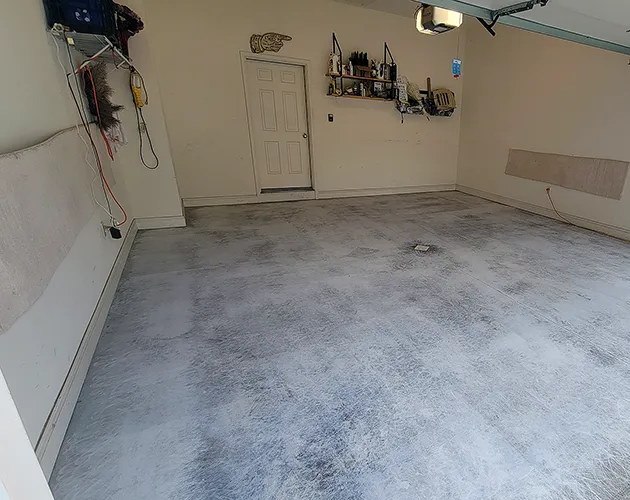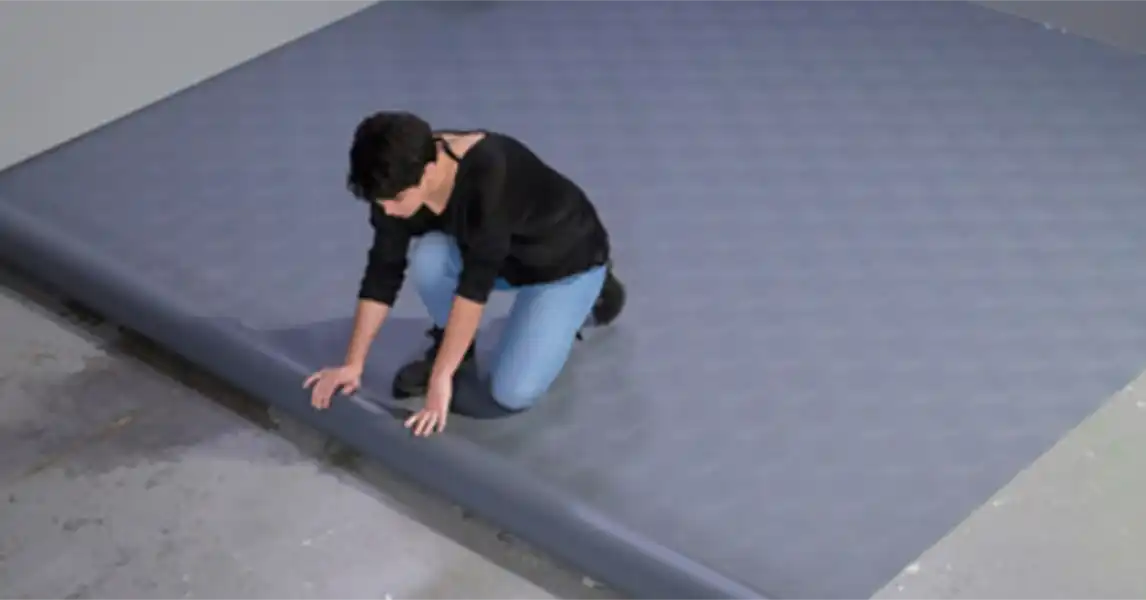There are all sorts of garage floor solutions. Some are professional solutions, such as our decorative chip floor coatings. Some are DIY, such as the epoxy paint kits sold at the big box stores or the snap together tiles. But the one we would recommend the least has to be the large, rollout floor mats some homeowners use to cover their garage floors.
NOTE: We are only talking about rollout floor mats that typically cover the entire garage not absorbent mats.
Unlike their full-floor counterparts, absorbent mats—often called containment or drip mats—are designed specifically to protect a limited area of the concrete from drips of oil, grease, and water. They are typically used under a parked vehicle's engine bay to contain leaks, and because they are smaller and easier to clean or replace, they can be a practical, albeit temporary, solution for managing minor fluid spills. This is a key difference from the large, floor-covering mats which are meant to provide a full-floor protective layer but often fail to offer a truly permanent or leak-proof solution.
5 Issues With Rollout Garage Mats
This article specifically deals with the large, heavy mats used to cover the entirety of a garage floor surface. It is not speaking to small catch mats slid under a vehicle or the thin, vehicle-sized mats.
These large rollout garage floor mats suffer from five key issues as detailed below.
Moisture gets trapped under the rollout mats
Even though websites often state it won’t happen, we have repeatedly seen moisture trapped under the non-breathable mats. Many homeowners have shown us the slimy feel of the mat’s bottom and concrete’s surface when the mats are removed.
In some cases, it has taken over a week for the concrete’s surface to completely dry out, as the concrete can pull water into the capillaries and other voids in the concrete mass.
NOTE: Same is true of carpeting the garage - something we have seen more than a few times. This is even worse than rollout mats, because the carpet gets musty and moldy from the moisture.
Odors from trapped material under the floor mats
We have replaced floor mats with coatings where the homeowners experienced odors emanating from under the mats (near edges or when rolled back). Several homeowners shared that when rolling back the mats to allow moisture to dry, they not only had a wet, slimy floor, but that it also smelled bad too.
This odor problem is also shared by some other garage flooring solutions, such as snap together tiles. Very applicable to carpet, but we do not consider carpet to be a valid garage flooring solution.
Floor mats show irregularities in the concrete underneath
Unless the garage floor starts out in good shape (free of surface imperfections), the rollout mats may telegraph the concrete surface's imperfections through the material. They will bulge up over ridges or fall into depressions or wide cracks.
If the floor has trench or PVC drains, the intentional slope to the drains may also create problem with the mats ability to conform to the concrete underneath.

Before we install our floor coatings, the concrete is first ground.
Floor mats often curl at the edges
Curling at the edges and corners is a very common problem with garage floor mats, often caused by temperature changes, how the mat was originally stored, or poor installation. When the edges of the floor mat curl, it creates tripping hazards and allows liquids and debris to get under those edges.
Most common at the edges of the garage door, it often requires one of the following to correct the issue:
- Reverse Rolling and Weight: We see homeowners placing heavy, flat objects on the corners and edges (like a plank of wood or bricks), but often needs done again and again.
- Applying Heat: If the mat can be removed, we know homeowners who periodically put the mat into sunlight on a warm day. Not a permanent solution and often requires repeating.
- Adhesives: For a more "permanent" fix, homeowners typically use a double-sided adhesive tape or a specialized flooring glue along the underside of the edges. While this is usually the most helpful thing tried, it usually cannot solve the problem unless the floor is very flat and does not have drains or surface damage.
Again, where drains are present, the mat must be cut to allow drainage and those edges of the mat around the drain want to curl, requiring additional gluing or taping.
While some mats are now sold with non-slip rubber backing or textures surfaces, these solutions may reduce sliding, but ultimately don't have enough surface friction to keep from moving over long periods of time.
Homeowners struggle with the weight of rollout floor mats
Rollout mats are typically 4 feet or greater in width and can be 20+ feet in length. Their bulk makes them hard to install and remove. If they shift over time from vehicles tires, readjusting the mats is not a simple matter. Removing and reinstalling the mats is not a quick or easy task.

Wrapping it up (the article – not the floor mat)
While roll out mats may be a good temporary solution for rented/leased properties, professional garage floor coatings makes a better long-term solution. Given the price per square foot of rollout mats, the spend isn’t worth the issues that come with the product.
For comparison: Using a 20'x20' garage, a professional decorative flake coating can be obtained usually be obtained for $2,500 to $3,000. A cheap garage matting system (online) priced around $800, but will not be seamless and does not include adhesives for the entire surface. Better quality matting system easily hit the same price as decorative flake coating, but still suffer from all 5 items above.
A high-quality floor coating alleviates the problems associated with heavy, rollout floor mats. Professional garage floor coatings do not allow anything to get “under” the coatings.
Plus, epoxy and polyaspartic polyurea coatings are easy to clean and there is nothing to periodically remove.
Editors Notes:
Significant changes were made to this article, which was first created in 2014. Republished on March 7, 2022.
Last Updated: Sep 17, 2025






